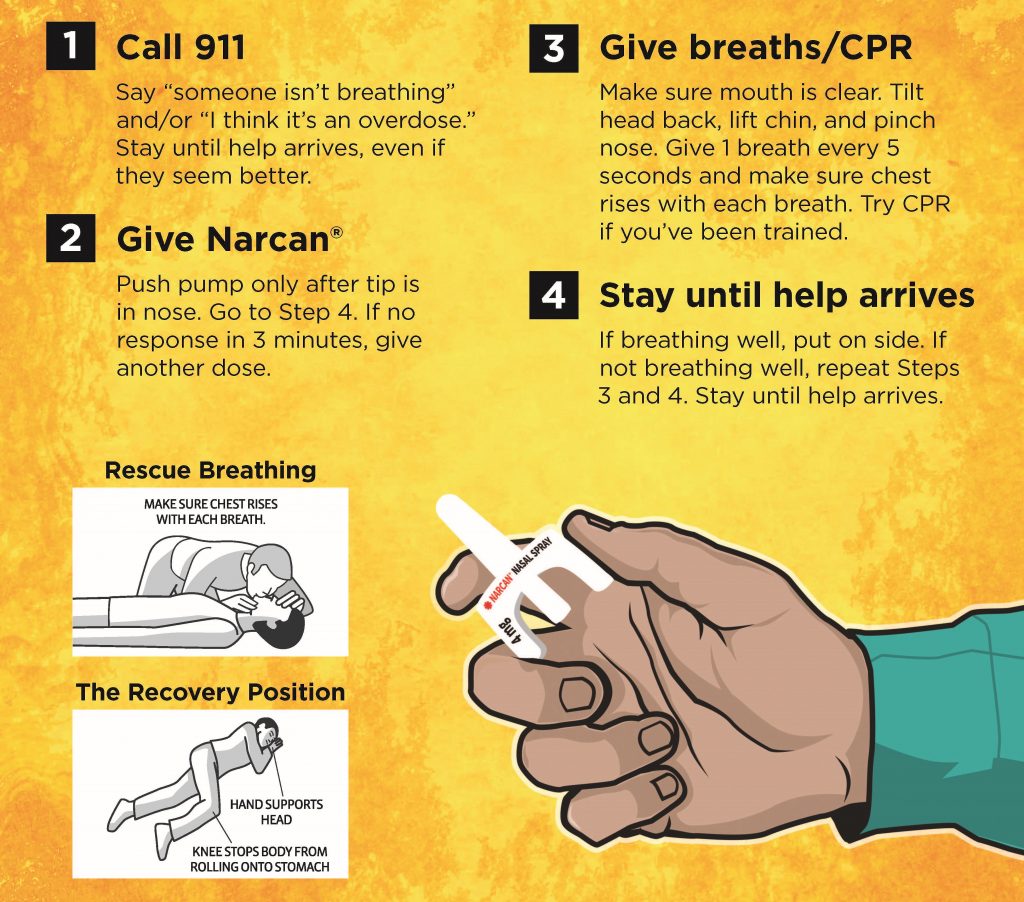Learn the signs of an opioid overdose and what you can do if you ever witness someone during an opioid overdose. Knowing the signs and actions you can take can save a life!
Learn the signs of an overdose.
Deep snoring, turning blue or grey (lips, fingernails), unresponsive, no breathing or slow breathing (less than 1 breath every 5 seconds)
A person having an opioid overdose may:
- Not respond to their name
- Breathe slowly (less than 1 breath in 5 seconds)
- Have blue or grey lips or fingertips
- Look very pale
- Go limp
- Make choking, gurgling, gasping, or snoring noises
- Vomit (throw up)
An overdose usually happens 1 to 3 hours after using drugs.
Know what to do and how to help.
Responding to an Overdose:
- Call 911 (Always call 911 first)
Say “My friend/child is unconscious, and I can’t wake him/her up.” or “My friend/child isn’t breathing.” In Massachusetts you cannot be charged with possession of a controlled substance.
Give the address or clearly describe your location. Say if the person is not breathing.
Give naloxone (Narcan) if you have it.
Push pump only after tip is in nose. If no response in 3 minutes, give another dose in the other nostril.

Good Samaritan Laws protect people from arrest and prosecution for drug possession when they call 911 to report an overdose.
- Try to wake the person up.
Yell their name, pinch them, or rub the middle of their chest hard.
If they’re not breathing, start rescue breathing.
- Rescue Breathing
If the person is not breathing, make sure there is nothing in the mouth; tilt head back; lift chin; pinch nose; give a breath every 5 seconds, and watch for their chest to rise with every breath. Continue until the start breathing.
- Stay with the Person Until Help Arrives
Whether or not the person needs rescue breathing stay (if you can) until help arrives.
If you need to leave, even briefly:
Put the person in the Recovery Position so they won’t choke if they vomit and leave door open so the emergency responders can find them easily
How to lower your risk if you are using
There are ways for you to lower risks even if you are still actively using opioids
- Don’t use alone and take turns when using so that one person can administer naloxone or get help if something goes wrong
- Try to avoid mixing drugs like benzos, alcohol, and opioids like heroin
- Educate those close to you (like family and friends) on what an overdose looks like and what to do if you overdose
- Always have Naloxone with you
- Be aware of your tolerance if you have not used in a while
- Remember you can always do more but you can’t do less, do a tester shot to check the potency (especially if it is a new batch and/or if you have not used in a while)
- Access your local Syringe Access Program
Source: Prescribe to Prevent
For more information on preventing an overdose, visit Prescribe to Prevent and StopOverdose.org.
